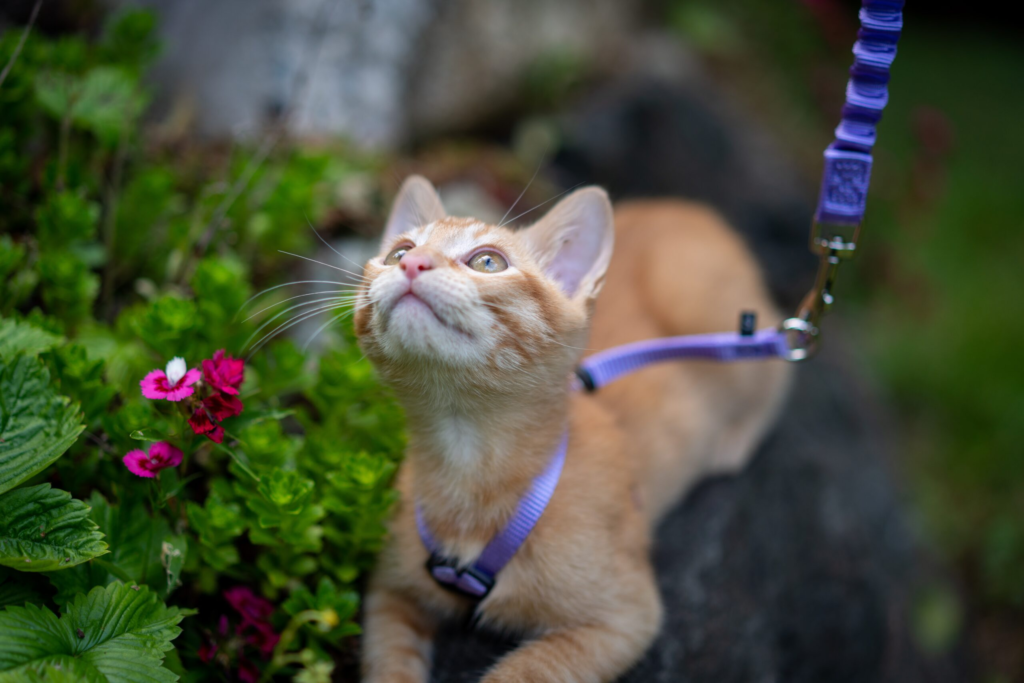Training your cat to walk on a leash can be an enriching experience for both you and your feline friend. Not only does it provide an opportunity for exercise and exploration, but it also strengthens the bond between you and your cat. However, leash training a cat requires patience, consistency, and the right approach. Here’s a step-by-step guide to successfully train your cat to walk on a leash.

1. Choose the Right Equipment
The first step in leash training is selecting the appropriate gear. Invest in a well-fitting harness specifically designed for cats, as it should be comfortable and secure. Avoid using collars for leash training, as they can be harmful. The harness should be adjustable and fit snugly but not too tight, allowing your cat to move freely without slipping out.
Choose a lightweight, flexible leash that’s about 4 to 6 feet long. Avoid retractable leashes, as they can be cumbersome and challenging to manage. A standard leash provides better control and safety during training.
2. Introduce the Harness Gradually
Begin by letting your cat get accustomed to the harness before attaching the leash. Place the harness near your cat’s feeding area or favorite resting spot to allow them to sniff and explore it. After a day or two, gently place the harness on your cat while they are calm, and let them wear it for short periods. Praise and reward them with treats to create positive associations with the harness.
Gradually increase the amount of time your cat wears the harness, ensuring they remain comfortable. If your cat resists or shows signs of distress, don’t force them; instead, go back to shorter periods and reward them for their cooperation.
3. Attach the Leash Indoors
Once your cat is comfortable wearing the harness, attach the leash and allow them to walk around the house while on a leash. Follow your cat around gently, allowing them to get used to the sensation of the leash. Avoid pulling or tugging on the leash, as this can cause fear or discomfort.
Use treats and praise to encourage your cat to walk and explore while on the leash. Allow your cat to lead the way, and follow them at a relaxed pace. The goal is to help your cat associate the leash with positive experiences and reduce any anxiety they may have.
4. Practice Indoors

Before venturing outside, continue practicing leash walking indoors. Use a secure, quiet space where your cat feels safe. Practice guiding your cat to follow you on a leash, rewarding them with treats and praise for walking with you. Short training sessions of 5 to 10 minutes, a few times a day, will help reinforce the behavior.
Introduce mild distractions, such as toys or household noises, to help your cat get used to handling various stimuli while on a leash. This helps prepare them for the more dynamic outdoor environment.
5. Gradually Introduce the Outdoors
When your cat seems comfortable walking on a leash indoors, it’s time to introduce them to the outdoors. Start with a quiet, enclosed area like your backyard or a small garden. Ensure that the area is secure and free from potential hazards.
Begin by allowing your cat to explore the new environment at their own pace. Keep the leash short to maintain control and prevent your cat from darting away. Observe their body language and be prepared to retreat to a safer location if they become overwhelmed or scared.
6. Build Up Confidence
As your cat becomes more comfortable outdoors, gradually increase the length and duration of your walks. Allow them to explore new areas at their own pace, offering treats and praise for calm behavior. Consistency is key, so make leash walks a regular part of your routine to help your cat build confidence and enjoy the experience.
7. Address Challenges
If your cat shows signs of fear or resistance, return to indoor training and work on building their confidence. Avoid punishing or scolding your cat, as this can hinder progress. Instead, focus on positive reinforcement and gradual exposure to new experiences.
Conclusion
Training your cat to walk on a leash can be a rewarding experience that offers physical and mental stimulation for your feline companion. By choosing the right equipment, introducing the harness and leash gradually, and practicing both indoors and outdoors, you can help your cat become comfortable and confident with leash walking. With patience and consistency, leash training can enhance your bond and provide enjoyable adventures for both you and your cat.


